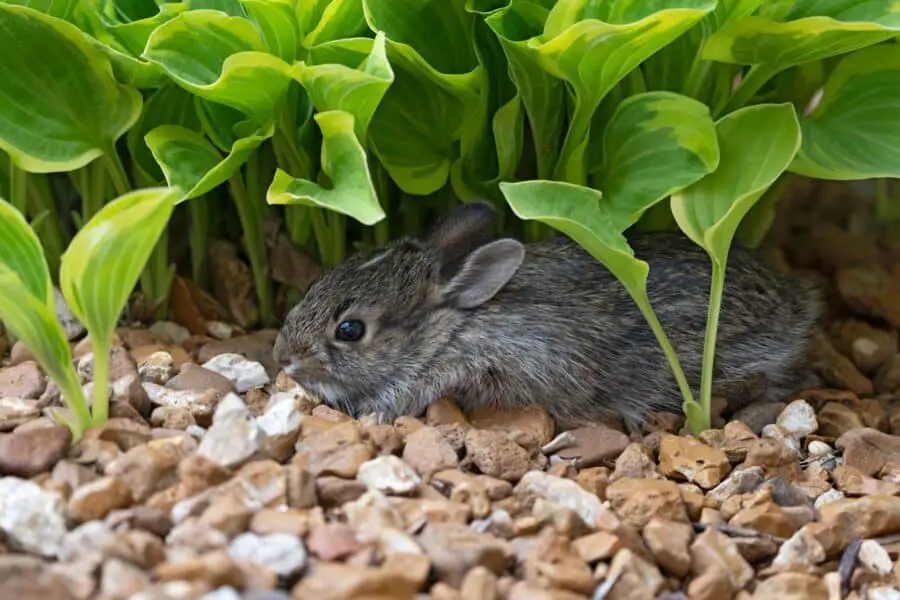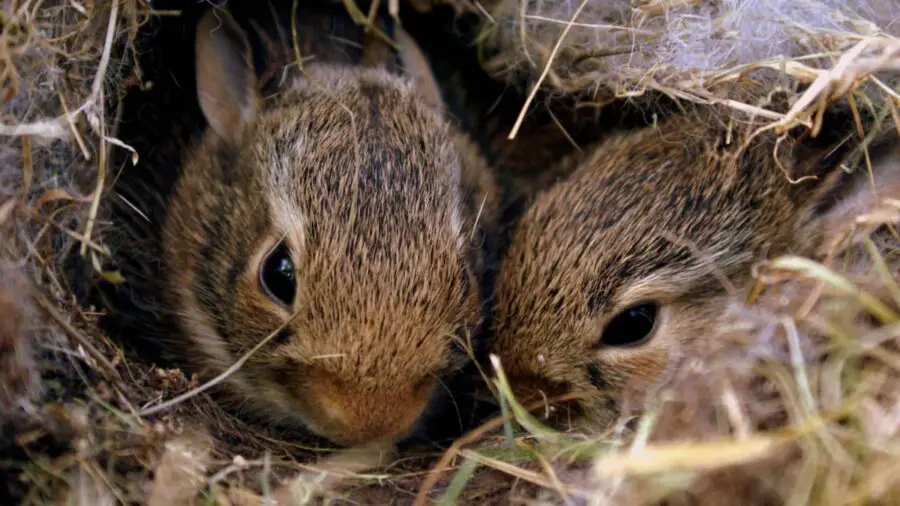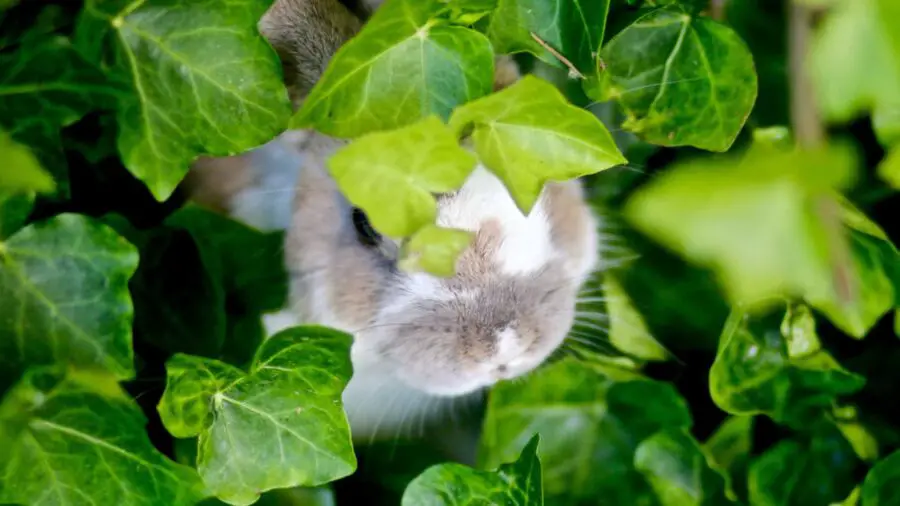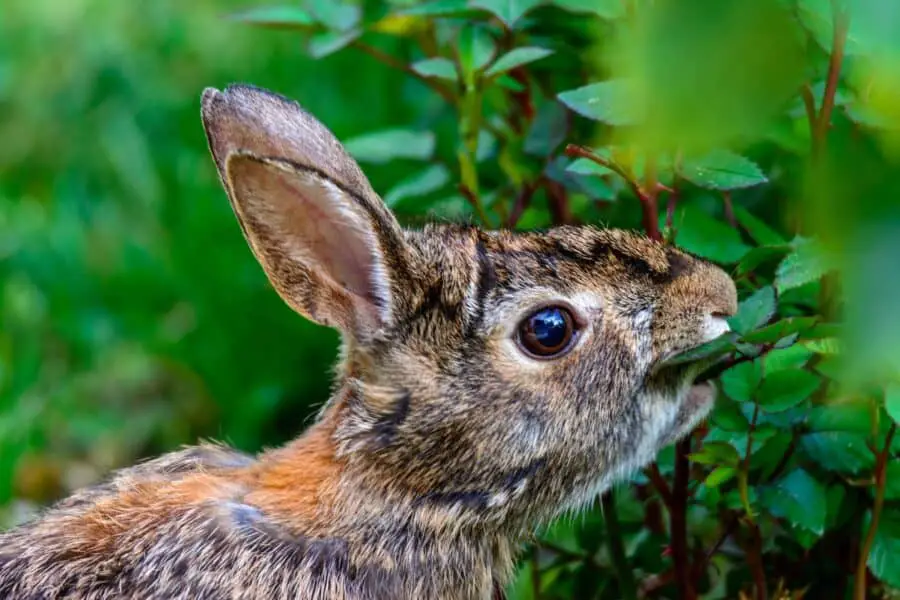Do rabbits eat hostas? Rabbits can wreak havoc on your plants if you don’t stop them, but there are several things you can try to save your plants. Read on…
Rabbits are one critter that can easily decimate your hostas if you don’t take steps to get rid of them and keep them away from your hostas. You’ll find rabbits all over the United States, and they’re a pest species that can quickly take over your flower beds or vegetable patches.
I know I was extremely frustrated when I’d wake up in the morning, go outside, and see my hostas eaten to the ground.
I decided I was going to put a stop to it, so I started experimenting and seeing which avenues worked best to keep the rabbits out, and I want to share my tips with you. If you’re curious, keep reading my guide.

Do Rabbits Eat Hostas?
Yes, rabbits can and do eat hosta plants. What’s worse, they don’t care what type of hostas you plant. I know some people claim that they only like certain types, but I experimented by planting a large variety.
When the rabbits came through, they ate all of them. It didn’t matter what type of style hosta they were.
| Are Hostas Poisonous to Humans, Pets and Rabbits | ||||
|---|---|---|---|---|
| Dogs | Cats | Rabbits | Humans | |
| Poisonous | Yes | Yes | No | No |
| Poisonous Substance | Saponins | Saponins | No | No |
| Symptoms | Abdominal pain, abnormal heartbeat, bloating, depression, diarrhea, distress, fatigue, intestinal twisting, loss of appetite, vomiting. | Abdominal pain, abnormal heartbeat, bloating, depression, diarrhea, distress, fatigue, intestinal twisting, loss of appetite, vomiting. | N/A | N/A |
| Deadly | Rare | Rare | No | No |
I noticed that the rabbits went for the hosta’s stems and new shoots over other parts of the plant. They will eat any part of the plant if they get hungry enough, but they tend to go after new growth first.
This can be wildly frustrating in the spring when you see these new plants springing up and the rabbits eat them to the ground. Another concern is your pets. Did you know hostas are poisonous to cats and dogs ?
This includes the hosta stem, leaves, flowers, and roots. Hostas contain toxins called saponins, and this attacks your dog or cat’s system when they ingest the hostas.
Hostas aren’t poisonous to rabbits because their systems, like humans, don’t react to the saponins in the hosta plant like a dog or cat’s system does. So, they’re not safe to have around your pets, but even young rabbits can eat them experiencing no problems.

What Does Rabbit Damage to Hostas Look Like?
What the rabbit damage to your hostas looks like depends on the severity of the rabbit infestation. If they only have a small window of time to eat the plants, they may not devastate them. However, a rabbit can eat a hosta so severely in a few scant hours that it kills the plant.
If you have new hostas coming up, they can eat the new shoots right down to the ground. They’ll eat the edges of the leaves until they look tattered, and they may even eat the leaves until there’s nothing left.
Rabbits will eat the entire hosta flower. If given the chance, rabbits will eat your hosta down to the root, and this is usually when you have to start over with new plants because it’s too damaged to survive and come back.
Newer hostas are more vulnerable than established ones.

How to Stop Rabbits From Eating Hostas
When you’re fighting an ongoing battle with the rabbits over your hosta plants, you realize that you’ll try just about everything to deter them.
However, what works well for some people may not work so well for others. Therefore, I’m going to give you an extensive list of tips, tricks, formulas, and advice you can arm yourself with and try on your own rabbit infestation.
The very first thing you want to do is clean up your yard or garden area. It’s easy to let brush pile up, leaves blow around, or weeds to get out of control, but these are all areas for rabbits to hide, eat, and make themselves at home.
So, take a weekend or an hour or two every day and go out and tidy up the yard. Keep the weeds pulled, the grass mowed, and the bushes or shrubbery neat. This will remove a lot of the temptation for the rabbits to stick around.

Another thing you want to do is block the rabbit’s access points underneath your porch or outbuildings. This is a prime spot for them to make a den, settle down, and have baby rabbits. If they do, your hostas are in even bigger danger.
Get chicken wire and staple it along the bottom of these areas to create a barrier where the rabbits can’t go through. Bury it a few inches in the ground if possible, so they don’t dig under it.
In my area, you can trap the rabbits too. Since the Department of Natural Resources (check with your state’s fish and game department) classifies rabbits as a nuisance species, you’re legally allowed to trap them on your property without a permit as long as the rabbits are:
Posing a safety or health threat to people or pets
Threatening to cause or causing property damage
If the rabbits don’t meet the requirements above, you will need a permit to shoot or trap them. You’ll have to get a nuisance wild animal control permit, or you’ll have to wait until rabbit season officially opens.
Once you trap the rabbits, you have 24 hours to euthanize them or take them to another location and let them go.
Video: How To Protect Your Garden From Rascally Rabbits
1. Physical Barriers to Stop Rabbits from Damaging Your Hostas
One of the more practical routes you can take is to erect physical barriers around your plants to keep the rabbits out. There are several ways you can go about this, and I’m going to explain each of them to you below.
Fencing
Go out and buy metal mesh fencing that is at least three or four feet high. If it’s not, the rabbits can simply jump over it. Ideally, your fencing will be around five feet high because you’re going to bury some of it in the ground.
Buy sturdy metal or wooden posts and place them around your hosta patch. These are what will support the fence and keep it upright.
Since rabbits like to dig, to bury the bottom of your fence at least six inches down into the ground. This will act like a deterrent, and set the fence a foot or so away from your hostas so the rabbits can’t reach through the fence to get it.
Your fence shouldn’t have openings any bigger than one inch by one inch, and it’s a good idea to do a double layer for additional protection. Consider adding ground staples to prevent burrowing and make sure your doorway is flush to the fence.
Row or Netting Cover
Typical netting stands no chance against rabbits, so you could opt for a fine mesh that is bendable and flexible while still being durable enough to withstand a rabbit attack.
You can get hoop frames and string the wire mesh over it to stop rabbits from getting to your hostas. You can form it into a cylinder, but it also works well strung around a wooden frame.
If you choose to use the wooden frame route, make sure you measure the area around your hostas. These are the measurements you’ll use to create your wooden frame.
You’ll want to string the mesh around the sides and over the top of the frame so rabbits can’t jump in. Carefully set the wire-enclosed frame over your hostas, moving it until your hostas aren’t right against the walls.
Plant Cages
If you only have a few hostas to protect, you can get away with using plant cages. I found out that I could repurpose a few old birdcages I had collecting dust. I just popped the bottom portion off and set the wire cage directly over the plants.
The sunlight and water fell through the slats, but the wire was thick enough to withstand rabbit bites.
Plant cages are circular wire structures that stand between three and four feet tall. You set them directly over your hosta and use four spikes to hold the cage to the ground.
This prevents the rabbits from getting under the cage and tipping it over. You can make them from chicken wire and mesh, or they come pre-made and ready to go out of a thicker-gauge wire.
Electric Fencing
Most electric fencing is thin wire, so this would work better if you paired it with a smaller-gauge fence or a netting cover. However, you can set the charge on the fence low enough that it scares the rabbit when they accidentally brush against it.
Once they learn that the fence equals a shock, they’ll start staying away and looking for food elsewhere.
2. Scent and Taste Deterrents
If fencing along doesn’t work (and it’s totally possible because some rabbits are stubborn critters), you might have to add scent and taste deterrents to the mix.
There are organic and commercial options available, but you can also DIY your own formulas with things you have lying around your home and kitchen. The only thing with these deterrents is that you will have to reapply them periodically.
| Ingredients in Rabbit Repellents | ||
|---|---|---|
| Ingredient | Safe Around Kids and Pets | Biodegrabable |
| Eggs | Yes | Yes |
| Milorganite | Yes | Yes |
| Bone Meal | Yes | Yes |
| Peppers/Hot Sauce | No - Eye and skin irritation | Yes |
| Ammonia | No - Irritation | Yes |
| Garlic | Yes | Yes |
Organic
We’ll start with organic deterrents. All this means is that the manufacturer doesn’t use chemicals when they create their formulas, and it’s usually healthier and safer to use around your kids and pets than other choices. A few examples of organic scent or taste deterrents include:
Bird-X Nature’s Defense Repellent—This product uses a non-toxic formula with a strong mint scent to deter rabbits. It’s 100% organic and safe to use around your pets and kids, and it has a granular formula that is easy to apply right around your hostas.
Nature’s Mace Deer and Rabbit Repellent—This repellent comes in a 40-ounce spray bottle that is ready to go as soon as you get it. You should apply it directly to the hostas and the surrounding soil. It’ll dry clear and odorless.
Plantskydd Organic Granular Animal Repellent—One bag of this organic scent deterrent will cover up to 3,500 feet. It comes listed by the Organic Materials Review Institute, and it has a satisfaction guarantee.
Enviro Pro Rabbit Scram Granular Repellent—You can spread this deterrent over the plant or around it, and it’s 100% organic with no lingering odors. Reapply after a heavy rainfall because it’ll soak in.
Commercial/Chemical
Commercial-grade rabbit deterrents contain chemicals, and they can have powerful smells associated with them. While this isn’t necessarily a bad thing, it can be unpleasant for you when you first apply them. You also want to keep your kids and pets away from them. A few options include:
Liquid Fence Deer & Rabbit Repellent—Liquid fence, well known for creating powerful deterrents that work for both scent and taste. You shouldn’t spray it on anything you plan to eat, and you have to give it a few hours to calm down because it has a very strong odor.
I Must Garden Rabbit Repellent—The strong, spicy scent of this deterrent is more than enough to keep rabbits at bay. It has a mix of botanical oils that creates an irritating scent that lingers for days around your hostas.
Bonide Repels-All Animal Repellent—This commercial-grade repellent causes mild irritation to the rabbit’s nose when they smell it, and this can scare them away from your plants. It has a biodegradable formula that you sprinkle around the hostas to ward the rabbits off.
Homemade
Finally, you can make a taste and scent deterrent in your home using things you have in your kitchen. Reapply this frequently because it doesn’t have the drying or sticking agents the organic or commercial formulas do.
Milk and Eggs – This recipe will make a gallon of deterrent. You’ll need ½ cup of milk, 1 gallon of water, 1 whole egg, 1 tablespoon of cooking oil, and 1 tablespoon of liquid dish detergent. You mix the milk, egg, cooking oil, and dish detergent in a gallon jug. Fill the rest up with water, shake it, add it to a spray bottle, and douse your hostas. The egg will help it stick.
Tabasco—If the rabbits are already nibbling on your plants, add one ounce of Tabasco sauce to one tablespoon of dish soap and add it to a quart bottle. Add hot water and shake it before applying it to your plants.
Garlic and Peppers—Get an empty milk jug and add five crushed garlic cloves, 1 tablespoon of dish soap, 1 teaspoon of crushed red peppers, and water. Mix it all up and pour it around your plants. The garlic will release a strong smell that mixes with the peppers.
Rotten Eggs—This one will smell terrible, and you should let it ferment out in the heat for a week before you use it. Mix a tablespoon of Tabasco sauce with five or six whole eggs. Add water, strain it out, put the lid on, and let it sit for a week. Apply it to and around your plants. The eggs will stick and dry to the plants to keep the scent close.
3. Electronic Repellents
Electronic repellents are very popular with gardeners, and there is more than one available thanks to technology. They’re nice because you can set them and let them run on their own. Most of them are motion-activated.
Motion-Activated Sprinklers
Most rabbits don’t enjoy getting wet, and they’ll run when they get a surprise spray from the sprinkler system. Therefore, motion-activated sprinklers are so nice. You can put these sprinklers around your hostas and in the middle of your hosta garden.
When a rabbit comes by them, they’ll trip the motion sensors and switch on the sprinklers.
Another nice thing about these motion-activated sprinklers is that they can emit a low noise when they go on, and the water itself creates noise. This can further startle the rabbits and scare them away from your garden and hostas each time it goes on.
Ultrasonic
This is an option if you don’t have dogs or cats in your home because it can negatively impact them, too. This device emits a high-frequency sound when it goes on that humans can’t hear. However, it can be more than enough to scare rabbits away.
A lot of these devices work up to 12 meters away from your hostas, so this gives them a wide berth, and you’ll need an AC power adaptor. Some run on batteries.
These devices usually have a very low profile that allows you to sick them into the dirt right near your plants.
They’re unobtrusive, won’t create an eye-sore, and they have very low maintenance requirements. You can get a few and line the perimeter around your hostas with them.
4. Animals
Simply having animals around your plants and outside is usually enough to scare the rabbits off and keep them well away from your plants.
Maybe you have an outdoor cat who likes to prowl through the plants and hang out on your porch. If so, no rabbit will come near it if they can smell the cat because they know cats are natural predators.
Dogs are another great deterrent, especially if you have outside ones. Dogs leave their scents all over the yards, and rabbits don’t like the smell. They can also be very loud, and loud noises will scare rabbits away as soon as they hear them. Your dog may even bark when they see the rabbits.
5. Decoy Animals
As a general rule, rabbits are skittish animals that won’t stick around if there are predators in the area. Luckily for us, they can’t tell the difference between a fake animal and a real one. They won’t take the chance of the animal being real.
You can get a few fake snakes and scatter them around your hostas. Just remember you put them there so you don’t accidentally scare yourself when you step on them.
Fake owls are another great option. You can buy decoy owls and set them up over your hostas. You may even want to set one right in the middle on a stump.
They come stationary and motion-activated, and some will make noises to seem more lifelike when something triggers the motion sensor.
6. Plants That Repel Rabbits
Many people think that garlic is a good rabbit repellent. It may be if you crush it up, but it’s mostly the oil that rabbits don’t like because it’s strong. However, it’s ineffective when it comes to protecting your plants, even if you put right on top of the leaves.
One plant that works well is Artemisia (wormwood). Wormwood can have a very rich and floral scent, but it has sharp bitter notes that you smell and taste. Rabbits don’t like these notes, and they’ll avoid an area with them in it. affect
You could also try putting marigolds or geraniums around your hostas. They both have potent scents that can be off-putting, and they can last for months.
Strawflowers have a stiff and papery feel that rabbits avoid, and snapdragons can be toxic to rabbits if they eat it.
Frequently Asked Questions
It’s understandable that you’ll have a lot of questions when it comes to keeping the rabbits away from your hostas. I picked out the biggest ones I noticed people asked most frequently and answered them for you below all in one spot.
Can you spray deterrents directly on your hostas to keep rabbits away
It depends. Some of the organic and homemade deterrents are safe to spray directly on the flowers, stems, and leaves of your hosta plant.
However, some commercial-grade or organic ones with botanical oils can burn the leaves. Make sure you double-check the label before you use it if you’re not 100% sure.
What smells do rabbits dislike
Rabbits have a very sharp sense of smell, so they don’t like strong scents because it smells so much worse to them. They don’t like eggs, garlic, tea tree oil, citrus oils, or tabasco or peppers, and vinegar.
Sometimes, you can put a little human or pet hair around your hostas to act like a deterrent because the scents cling to them.
Do Epsom salts keep rabbits away
Yes, and no. It’s nice because you can sprinkle it directly on and around your plants, and it may work for a day or two. However, it washes away in the rain or water, so you replace it again and again. See our article that tells of other uses for Epsom salts.
Does cutting away foliage keep rabbits away
Yes. Since rabbits are skittish animals, they like to know they have places to hide instead of wide-open areas. If you cut away foliage, clean up your yard, and remove these natural hiding places, the rabbits will be more prone to stay away.
How often should you replace your homemade rabbit repellent
Depending on the ingredients, you could find yourself remaking the repellent every few weeks. Some repellents work better after you let them sit for a month. If you notice that the smell isn’t as potent when you spray it, you can either add more ingredients or completely remake it.
Final Thoughts
It is possible to protect your hostas from rabbits and other pests, and I’ve given you several viable options to try. Some may work better than others, but I encourage you to keep trying until you find the best one.
If you do, you’ll have beautiful hostas all season long. Keeping your hostas growing well will help them recover from rabbit damage. Watch the watering, apply fertilizer properly, keep improving your soil, and use mulch.